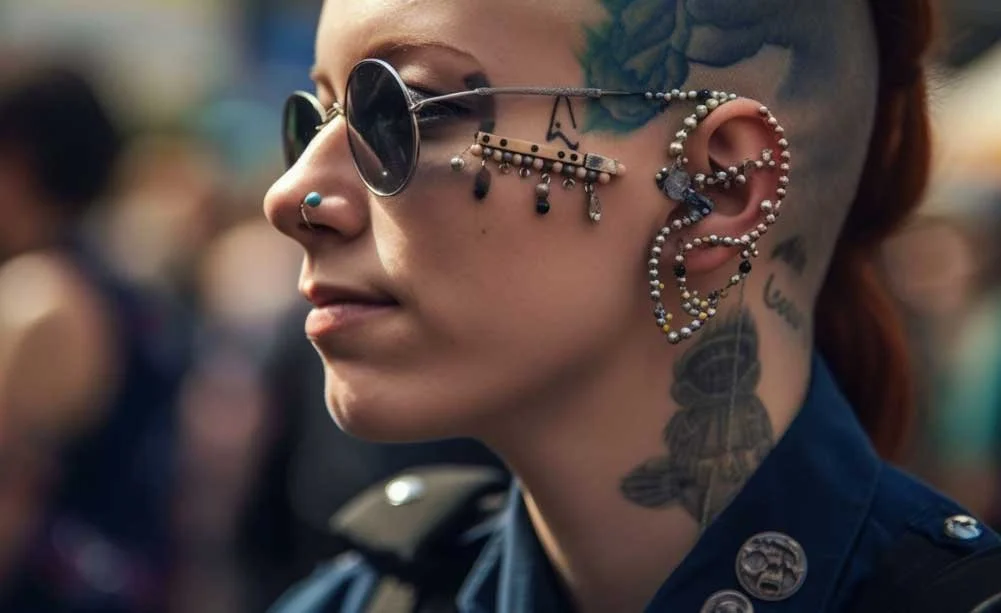Can Police Officers Have Piercings?
In the vibrant and diverse cultural melting pot that is modern society, body art, such as tattoos and piercings, has become increasingly mainstream and widely accepted. However, certain professions still maintain a stringent and traditional dress code, and one such example is the police force. This raises the question: Can police officers have piercings?
The answer to this question is not straightforward and requires a comprehensive exploration of the different rules and regulations that govern the police force across various regions and jurisdictions.
Related Questions
-
Most police agencies have strict requirements for their officers, even while off duty.
These restrictions apply to earrings and typically prohibit male officers from wearing them, even while off duty, and limit female officers to wearing 1 or 2 pairs of stud earrings while off duty.
However, these restrictions vary by jurisdiction, so for the best answer, consider researching or contacting the law enforcement agency in question.
-
The acceptance of tattoos among police officers in the United States has become increasingly common in recent years. However, policies regarding tattoos can still vary between law enforcement agencies.
Many police departments have relaxed their regulations and now permit officers to have visible tattoos, while others may still maintain stricter guidelines.
-
The acceptability of hand tattoos for police officers is often subject to stricter regulations compared to other areas of the body. Hand tattoos, due to their visibility, may be seen as more unprofessional or potentially distracting.
Some police departments may have explicit policies that prohibit officers from having visible tattoos on their hands, while others may allow small and discreet hand tattoos.
Short Answer:
Q: Can police officers have piercings?
A: Not usually.
Although there is no set rule for police officers nationwide preventing or allowing piercings, most police agencies prohibit their officers from having any visible body piercings including, but not limited to, tongue piercings, lip piercings, nose piercings, and brow piercings.
These restrictions generally apply to officers both on and off duty.
Additionally, most agencies prohibit male officers from wearing earrings, while allowing female officers to wear a maximum of two earrings per ear.
However, as the general public becomes increasingly accepting of diversity of all kinds, these rules are likely to change.
Dress Codes and General Appearance
Uniformity, professionalism, and authority are at the core of a police officer's appearance. The uniform serves not only as a visual symbol of the law but also communicates the order and discipline inherent in the job. It helps civilians identify officers in the case of emergencies and also plays a part in shaping the public's perception of the police force.
Traditionally, the police force has required officers to present themselves in a manner that conforms to a standardized dress code, which often does not allow visible tattoos or body piercings, barring those for medical or religious reasons. This is largely due to the belief that such displays can be distracting or may undermine the perceived professionalism and authority of the officer.
Variations Across Jurisdictions
However, it is crucial to note that police dress code regulations can vary greatly depending on the jurisdiction. For instance, in some urban areas where the cultural norm leans towards greater self-expression, local police departments may allow officers to have visible tattoos or certain types of body piercings.
There has been a gradual shift towards more lenient policies in recent years. This is partly due to the recognition that overly stringent appearance standards can hamper recruitment efforts, particularly among younger generations who view body art as a form of self-expression. Nevertheless, even in these cases, there are typically limitations on the type, size, and number of piercings allowed.
Safety Considerations
Safety considerations also play a significant role in the policy against piercings. Officers often find themselves in situations where a piercing could present a physical risk, such as hand-to-hand combat or pursuits. In these scenarios, a piercing can potentially be grabbed, pulled, or otherwise manipulated, causing severe injury to the officer.
Implications for Police Recruitment and Diversity
The issue of police officers having piercings touches on broader themes of diversity and inclusion within the force. Stricter dress codes can, inadvertently, exclude individuals who may be excellent candidates for the force but choose to express their cultural, personal, or individual identity through body modification.
This is a significant concern in an era where police departments worldwide are striving to enhance their diversity and inclusivity, reflecting the communities they serve. Overly restrictive appearance policies can deter potential applicants and limit the pool of recruits.
However, it is a delicate balancing act, as police forces also need to maintain an image of professionalism and authority. The challenge lies in finding a compromise that allows officers to express their individuality while still projecting an image of uniformity and respectability.
Conclusion
In conclusion, whether police officers can have piercings largely depends on the specific policies of the jurisdiction they work in, and these policies are influenced by a variety of factors, including cultural norms, safety considerations, and the need for a professional image. It is a complex issue that reflects broader societal debates about conformity, diversity, and the evolving perception of body modification.
The debate on police officers having piercings and other forms of body art is far from over. As society continues to evolve and becomes more accepting of different forms of self-expression, it is likely that police forces will continue to grapple with these issues and adapt their policies accordingly.








Inside the Investigation: A Deeper Dive into Police Detective Benefits